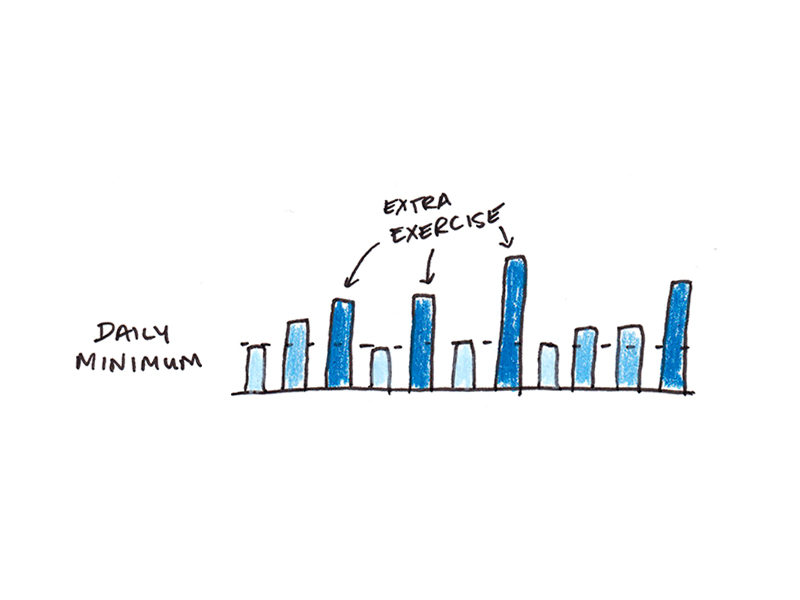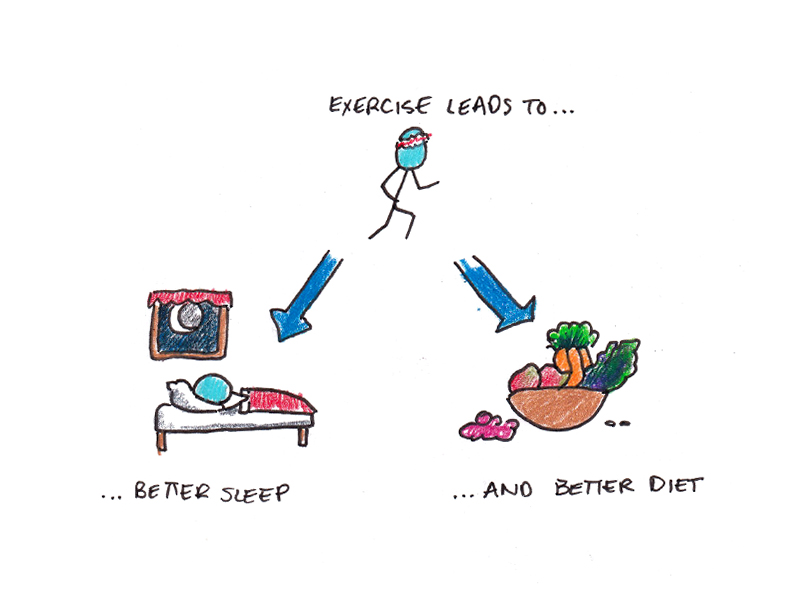As I write this, I’m concluding the first month of my year-long foundations project.1 The first month’s foundation was fitness.
You can read my opening update here and my post covering all the books I read this month here. In this essay, I’ll be focusing on how the first month went for me personally, as well as my long-term plans in the future.
My wife and I also decided that we’d record some conversations about each month of the project as they progress. Feel free to watch on YouTube below, or listen on my podcast:
Exercising Every Day for One Month
The keystone habit for this month was to do at least thirty minutes of daily exercise. I’m happy to say that I was able to hit every day this month without exceptions.

Perfect attendance is always nice to strive for, but it’s also something you shouldn’t beat yourself up about if you can’t reach. It’s far better to be the kind of person who misses a day and gets right back up the next day, than the kind of person who says they “failed” and gives up due to a single misstep. Still, it was nice that nothing prevented me from being able to go every day.
I had some worries about the 6 am workout slot, especially since I haven’t been a consistent morning exerciser in the past. But now, a month in, I can see this is clearly the best habit for this stage of my life. My kids already wake up around this time, so it wasn’t as if sleeping in was an option. Starting the day with a workout also dramatically reduces the amount of ad-hoc scheduling I need to do to fit it in later.
In addition to hitting my basic daily workout goal, I also managed to balance my cardio and resistance training, another weakness of my previous approach. In the past, I’ve tended to go through bouts of doing almost entirely weights to doing almost entirely cardio without enough balance between the two. But my plan of doing weights every third day (rotating through push/pull/legs) has worked out pretty well.2
Side Effects of the Fitness Focus
In addition to the central aims of the month: reading a lot of books, plus sticking to my minimum daily exercise commitment, I found there were a lot of spillover effects of my challenge.
First, while my commitment was only to exercise for thirty minutes, putting it in my calendar daily meant that there were plenty of times I worked out more—it just wasn’t mandatory. I ran for quite a few of my cardio days for the month, and as my endurance went up, I found myself running longer just for fun. My longest run of the month was a little under 12km (7.5 miles)—a distance I don’t think I had run since I was a teenager.

Second, I ended up walking a lot more. Again, it wasn’t something I felt pressured to do; it just made sense. The weather was nice, and I had a lot of audiobooks to get through for research, so I started walking to work instead of taking the train. My average daily step count was around 17,000. I don’t have any specific plans to sustain that long-term, but it was a nice bonus.
Third, I started eating healthier. While the dietary foundation isn’t for a few months, it felt natural to eat a bit better and be more mindful of that during this month as well. I think it can sometimes be a mistake to commit to too much all at once. But sometimes, when you focus on one thing, you’ll see multiple changes happening simultaneously, especially if they’re encouraged by a similar mindset.

The major cost of my fitness habit seems to be needing to go to sleep a bit earlier. I used to go to sleep between 10 and 11 pm, but now I’m getting to sleep closer to 9:30 or 10 pm. It’s not a bad trade-off overall, but I want to be aware of it, especially as I focus other months on relationships and spending time with friends or my wife.
One-Month Results
My concrete outcomes for the month (as opposed to behavioral change), were relatively modest.
I lost about 4 or 5 pounds, but I didn’t do any body fat composition tests, so it’s hard to know what the change in lean mass was. Given that my goal wasn’t to lose weight, nor was I trying to reduce my food intake in any specific way, I consider it a nice bonus.
My running endurance and speed went up modestly. But given the short duration of most runs, this wasn’t something I was optimizing for during training. Additionally, while I did make improvements in my strength, I would attribute almost all of that to the “beginner gains” associated with starting a new lifting program.
Subjectively, I feel fitter and healthier. I have more energy, and I’m sleeping better. I think these are substantial effects, but I’m also aware of the placebo effect in sudden changes like these, so I’m hesitant to fully ascribe them to the exercise itself. Still, placebo or not, it’s a good affirmation of why I wanted to strengthen this foundation in the first place.
Ultimately, I’m happy with the results, but I don’t actually care so much about the short-term outcomes. The real test of this month’s challenge isn’t whether I can lose weight or get stronger in a short period of time but whether I can clearly see a bend in the long-term trend line of my overall fitness a year or two from now.
Plans for the Long-Term
Overall, I like the morning exercise habit. I never thought I would be, but I guess I’m now one of those guys who wakes up early to go running every day.
My exercise habit feels fairly stable now, so I’m not too worried about switching gears to the next foundation. But I’m also aware that my fitness habit isn’t at the point where I can totally relax and not worry about things slipping. One month is enough to make a change feel normal, but I’ll probably need 6 to 12 months before it’s so automatic that I could take a week off without worrying about it.
So my plan is to try to be strict about the daily rhythm for at least another few months, aiming to exercise each morning, even if I’m on vacation or plan to do different physical activities later in the same day.
Additionally, while I’ve been enjoying outdoor runs, I’m not sure they will continue as the weather worsens. While I know plenty of rain-or-shine runners here in Vancouver, I don’t want to make my plan hinge on waking up at 5:45 am to run in the cold rain come January. So it may be that I switch to a treadmill or stationary bike at the gym those days to make it easier on myself.
While the first month’s foundation is officially done, the real test of whether the new changes worked will only be evident at the end of the year. Thus, I’ll try to keep an update on this foundation and the others as I go into future months.
Next week, I’ll share my opening update for the next month’s foundation—productivity.
Footnotes
- Due to the challenge of publishing content live while also running a course, I’m releasing these updates with a three-month delay. So I’m writing this on July 31st, 2024, as I finish my first month, and publishing it at the end of October 2024, when students in my Foundations course are wrapping up their first month. Hopefully, this approach will help me avoid the bias of reflecting on each foundation months after the fact.
- There is some research arguing that training gains from a balanced approach are sometimes suboptimal, particularly for strength gains. However, given that my main aims are health-related rather than athletic achievement, I’m fine if my level of cardio slows my strength gains, given the health benefits of a more rounded fitness profile.


 I'm a Wall Street Journal bestselling author, podcast host, computer programmer and an avid reader. Since 2006, I've published weekly essays on this website to help people like you learn and think better. My work has been featured in The New York Times, BBC, TEDx, Pocket, Business Insider and more. I don't promise I have all the answers, just a place to start.
I'm a Wall Street Journal bestselling author, podcast host, computer programmer and an avid reader. Since 2006, I've published weekly essays on this website to help people like you learn and think better. My work has been featured in The New York Times, BBC, TEDx, Pocket, Business Insider and more. I don't promise I have all the answers, just a place to start.